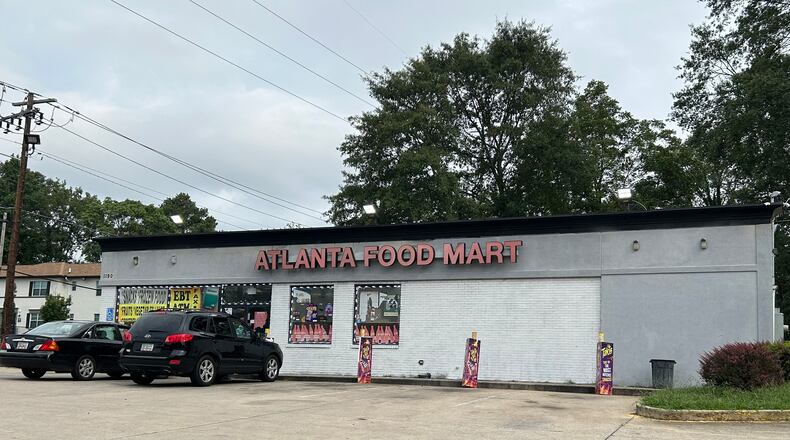Disparities in access to fresh produce continue to affect Black and lower income neighborhoods in Atlanta, a newly released study by Emory University found.
The study, which was led by the Healthy Food Retail Research Team at Emory, focused on small-food stores, also known as corner stores, dollar stores and convenience stores, finding that less than 44% of these retailers had fresh produce available. Additionally, produce availability was not equal across neighborhoods in the city of Atlanta.
“This is not a new issue for Atlanta. It’s also not only an Atlanta issue,” said Dr. Megan Winkler, one of the report’s authors. “But, I think what’s really important for folks to understand is there are things we can do about it.”
The team, which included co-author Angela Zhang, looked at 150 small-food stores, randomly selected from an original pool of 359 stores during the spring of 2022, using metrics that included produce availability, product promotion, pricing information, shelf space, produce variety and produce availability.
From the analysis of these stores, researchers found that these small-food retailers were unevenly distributed across neighborhoods. In communities of color and low-income neighborhoods, grocery stores are scarce but small-food retailers are in abundance, fueling disparities in access to fresh produce.
Credit: Emory University
Credit: Emory University
Credit: Emory University
Credit: Emory University
According to the report, Black neighborhoods compared to non-Black neighborhoods were more likely to have dollar stores and convenience stores as opposed to corporate, franchise retailers. To Zhang, this showed a cycle of underinvestment in Black and lower-income areas.
“Neighborhoods with less resources tend to get less investment from larger corporations and chains because they [companies] are more inclined to invest their money in neighborhoods that already have resources,” she said. “This leaves communities with less resources having less access to these infrastructures and fresh produce.”
Additionally, over half or 61% of stores in non-Black neighborhoods carried fresh produce, compared to only 36% of stores in Black neighborhoods.
Health experts have long advised people to eat fruits and vegetables as part of balanced and healthy diet, but the Centers for Disease Control and Prevention found that over 80% of adult Americans are not meeting recommended daily fruit and vegetable intake. However, barriers to accessing fresh produce greatly impacts intake.
Disparities exist among retailers in Atlanta who accept food stamps, also known as SNAP (Supplemental Nutrition Assistance Program). Researchers found that 75% of SNAP retailers in non-Black neighborhoods made produce available as opposed to 38% of retailers in Black neighborhoods.
“Everyone deserves the chance to be able to buy or choose healthy products and fresh produce,” Winkler said. “I think‚ in our results, we really show that there are systemic patterns that are showing that’s not the case across the city of Atlanta.”
Along with findings of the report, its authors laid out recommendations to improve access to fresh produce for Black and lower-income areas in Atlanta.
Among those recommendations are: A city ordinance requiring dollar stores to carry fruits and vegetables; offering tax incentives to small-food retailers to increase fresh food options; updating SNAP retailer requirements to require the stocking of fresh produce; and providing infrastructure and technical assistance to stores willing to stock fresh produce.
Additionally, the authors suggested partnerships between the city with local and regional farms to create gleaning programs to use thousands of pounds of produce that would otherwise be wasted, retailers working with regional produce distributors to supply and promote fresh produce snacks and city and community organizations to promote healthier habits through education and incentive programs.
“I really hope that folks feel empowered with this knowledge to really start to reinvigorate action and change for this. I do think it’s going to need multiple things,” said Winkler. “If you’re somebody that can do something, you should be doing something.”
More from the study by the Healthy Food Retail Research Team:
Emory’s study looked at 150 eligible stores randomly selected to represent proportions of convenience stores, gas-marts, dollar stores, and pharmacies that matched the original eligible sample of 359 stores.
The study notes:
- Only 1 in 10 U.S. adults meet their fruit and vegetable intake recommendations.
- 75% of Atlanta’s residents lived within a half-mile of fresh produce in 2020 compared to 52% in 2015 with improved access occurring primarily in neighborhoods with higher proportions of white residents.
- Less than half, or 44%, of small food stores carried fresh produce overall. Only 36% of the stores in majority-Black neighborhoods carried fresh produce compared to 61% in non-majority-Black neighborhoods
The Atlanta Journal-Constitution and Report for America are partnering to add more journalists to cover topics important to our community. Please help us fund this important work at ajc.com/give
About the Author
The Latest
Featured





